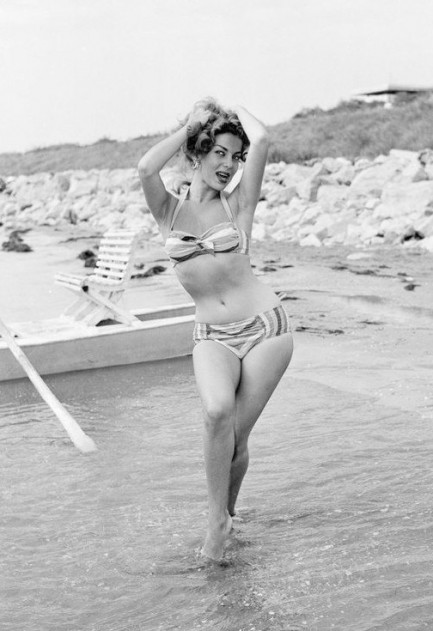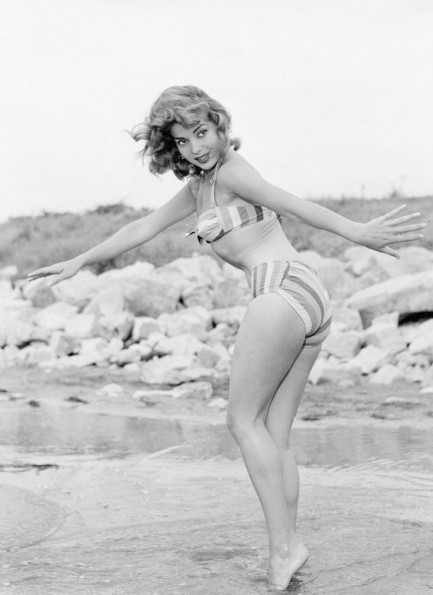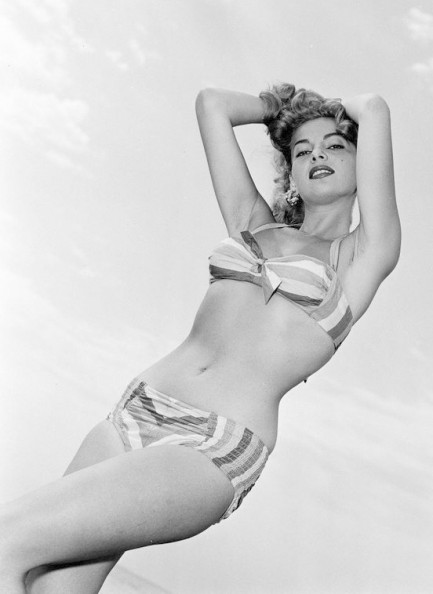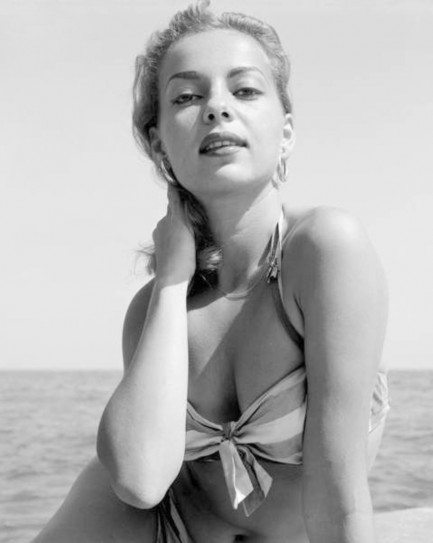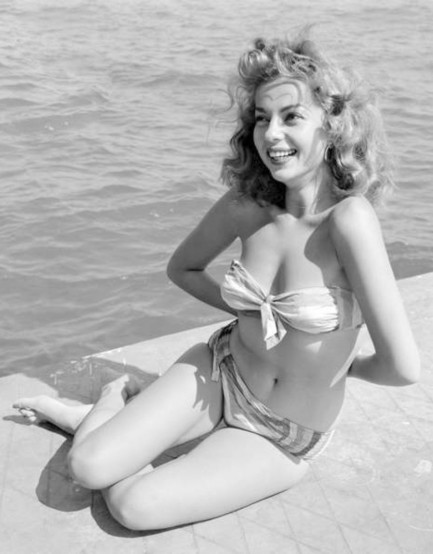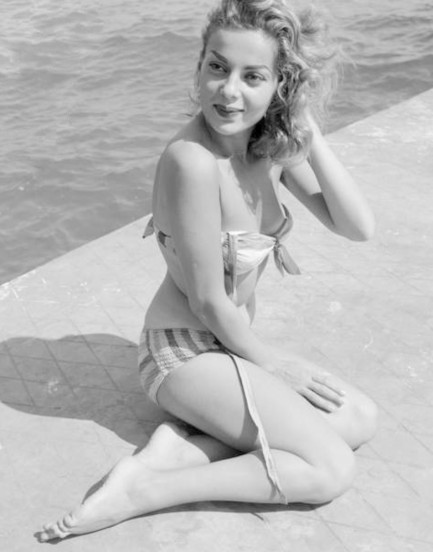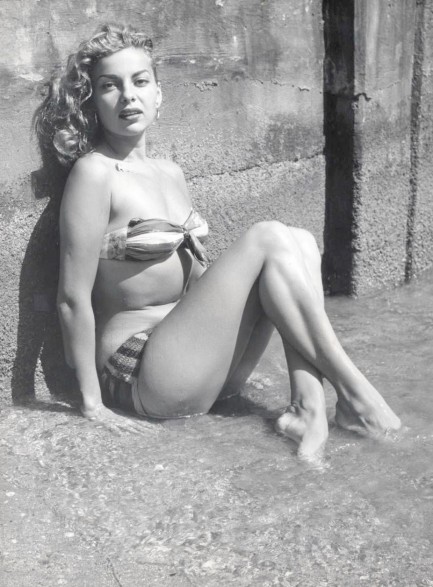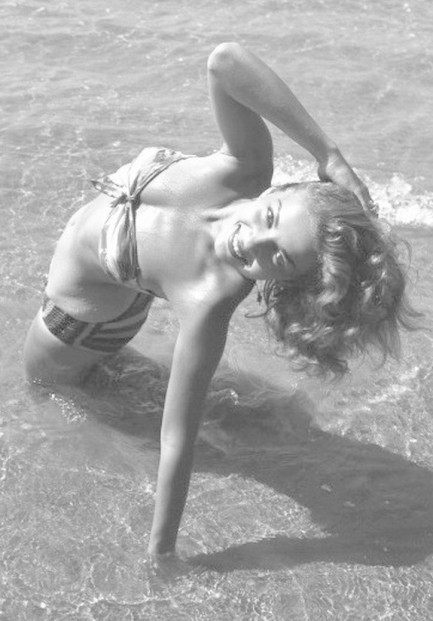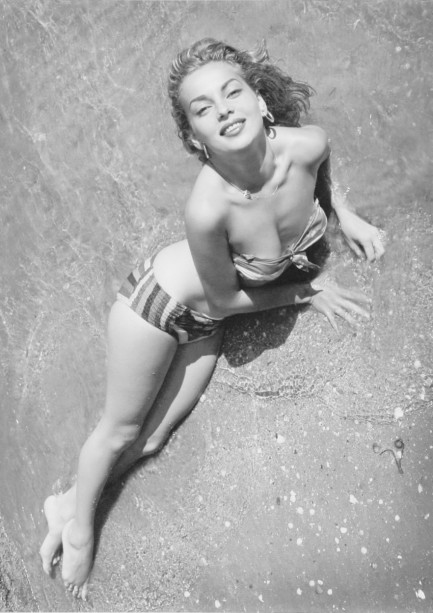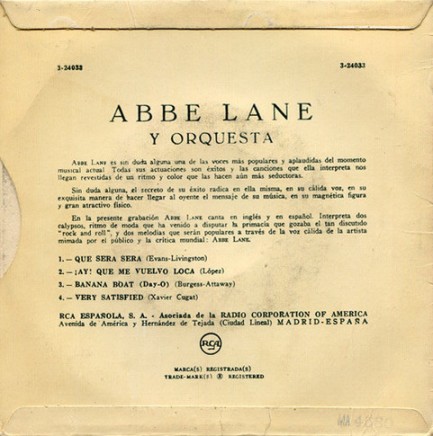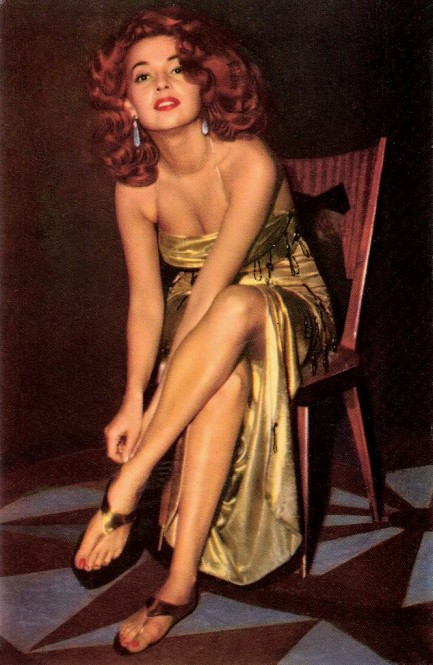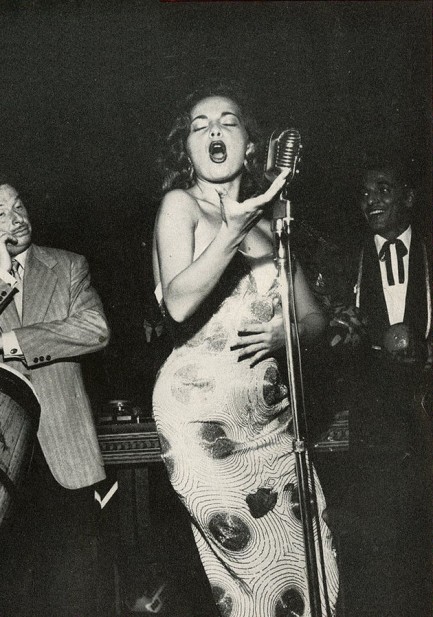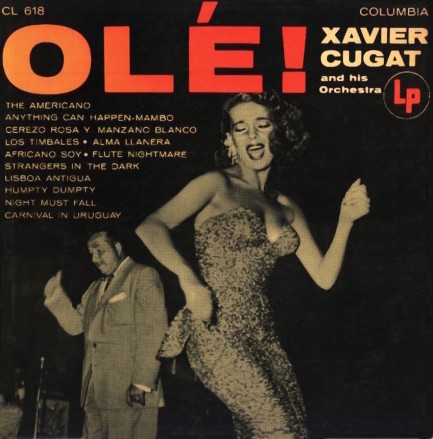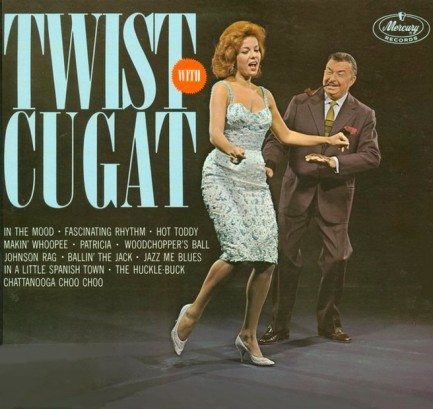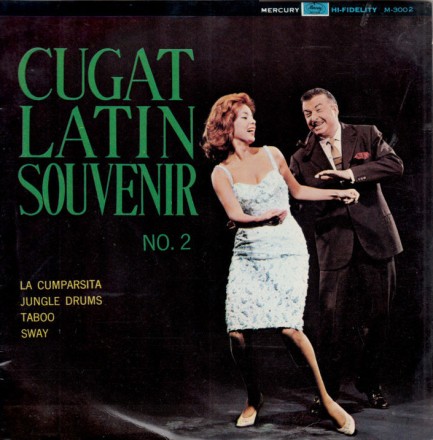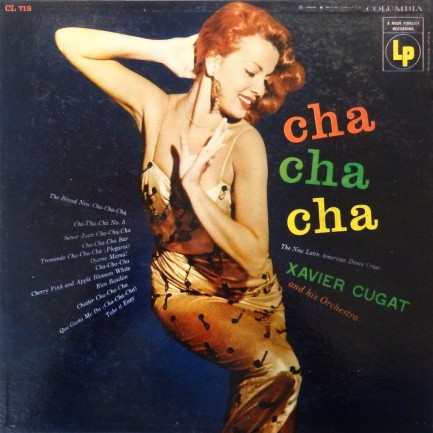 It was the Whisper heard from coast to coast. 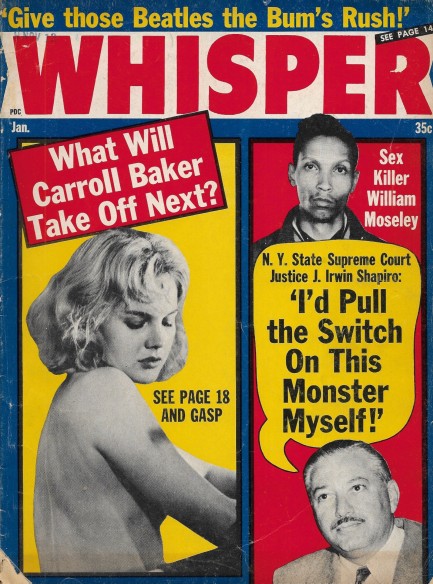
Above is a cover of the tabloid Whisper from January 1965, with actress Carroll Baker, convicted murderer Winston Moseley, and New York judge J. Irwin Shapiro starring on the front. But before we get into the magazine, we want to share the good news that our longtime scanning problems are fixed. We didn't get a new scanner, though. We got a new computer—a Mac Studio with plenty under the hood. It's quicker than the old Mac, but it also changed the functionality of the scanning interface. The whole process runs differently, and is about three times faster now. So you'll be seeing more magazines in the future. Turning back to Whisper, Winston Moseley—who editors call William for some reason—was America's villain of the moment for the murder of Catherine Genovese, who he stalked, stabbed with a hunting knife, then found again where she had taken refuge in a building, and finished her off. Additionally, Moseley was a necrophiliac. He raped his victims—of which there were three total—post-mortem. Of the trio of victims Genovese is the one that's remembered today because her murder sparked a national reckoning about the relationship between citizens and the police, as well as life in big cities, because the press reported that thirty-eight people had seen the crime happening but had done nothing. As it turned out, that number was wildly inaccurate, but never let the truth get in the way of perfectly cooked, juicy tabloid outrage. A quote appeared in nearly every story about the murder: “I didn't want to get involved.” New York City—where the crime occurred—and other metropolitan centers were criticized as uncaring places. Author Harlan Ellison, who at that time was writing urban crime fiction, weighed in, saying, “not one of [the witnesses] made the slightest effort to save her, to scream at the killer, or even to call the police.” Peak outrage was achieved by New York State Supreme Court Justice J. Irwin Shapiro when he expressed a desire to execute Moseley himself. In the end, Moseley wasn't executed at all. He died in prison in 2016 at age eighty-one.
Elsewhere in Whisper, you'll notice that the magazine is—unsurprisingly, given the time period and nature of the publication—antagonistic toward gay men, as demonstrated by the panel with the blaring text: “Who's Queer Asked the Peer?” But what is a surprise is that later in the issue the editors run a detailed piece on transvestites and transsexuals, and the approach is very different than the contempt shown toward homosexuality. As we've pointed out many times before, mid-century tabloids had a deep interest in trans issues. The story is titled, “A Doctor Answers What Everyone Wants To Know About Sex Change Operations.” The tone is as follows:
The condition he referred to was the common plight of all male transsexuals. Physically he was a man, but emotionally and personality-wise he was a woman, a condition that made it difficult to find successful employment, and to live at all happily. Fortunately, in his case, he had a lawyer and a wise judge who were able to help him in his wish to go to Europe for a sex change operation so that his body could be brought into greater harmony with his mind, and enable him to work and live with a degree of happiness he had never known before.
That's respectful—if not even compassionate—for a 1965 publication considered lowbrow by sophisticated readers. Is it a paradox that the magazine could be so evil toward gay men, yet so civil toward transsexuals? We think so, and we'd love to know the thought process behind it. While we're puzzling that out, you may want to move on to Whisper's slate of celebrity news. Everyone from Romy Schneider to Ernest Borgnine get their due exposure. We've uploaded the magazine's “Behind the Whispers” feature, so you can get the dish on a few Hollywood stars. Please enjoy.
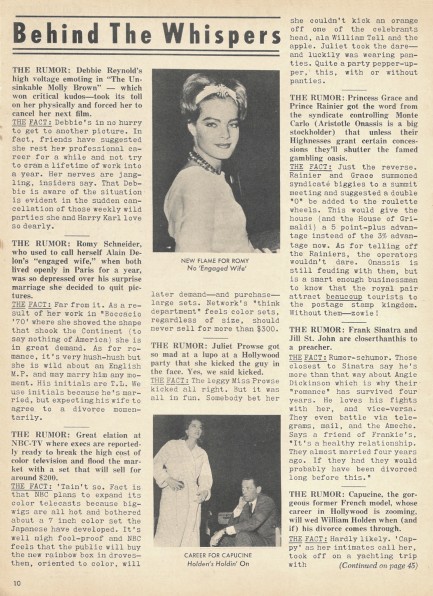   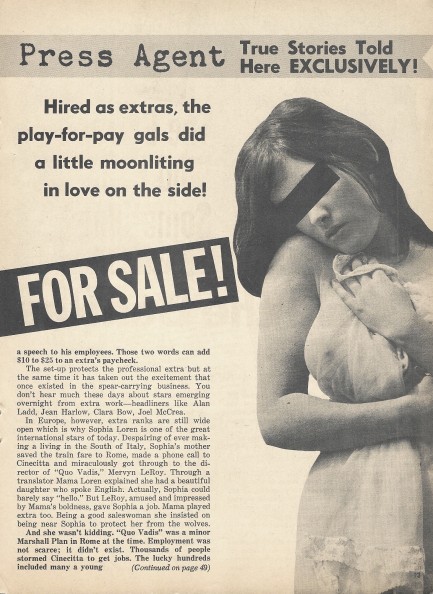 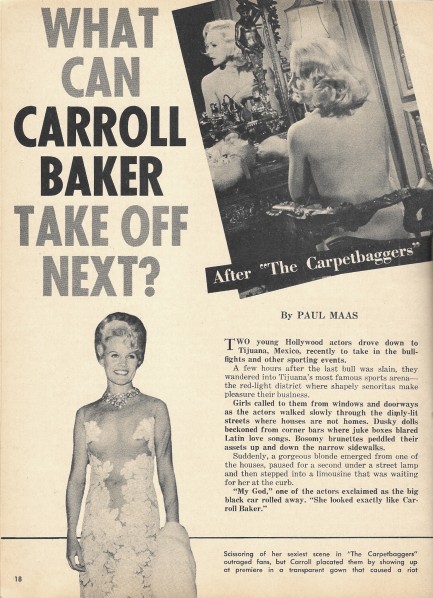 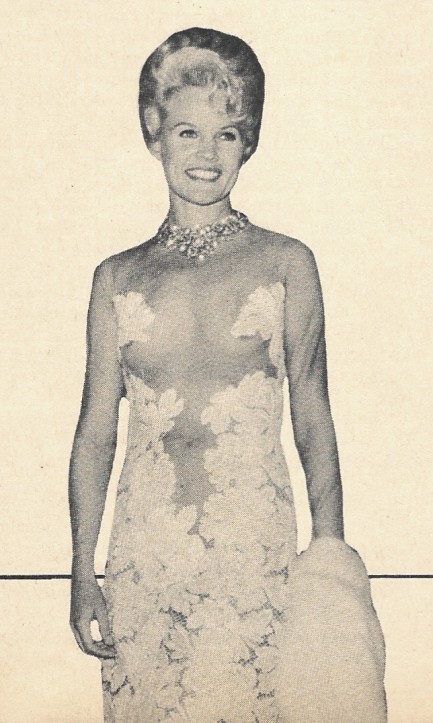 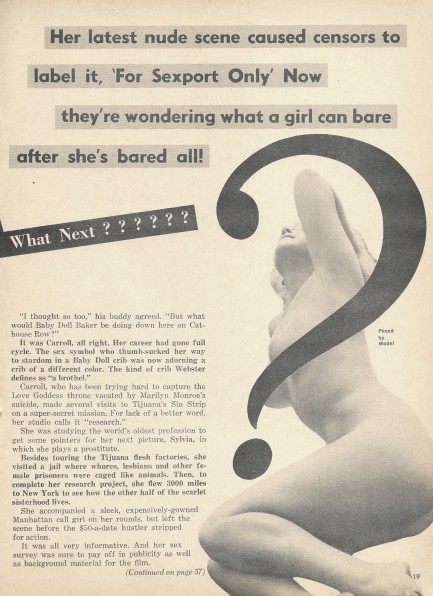 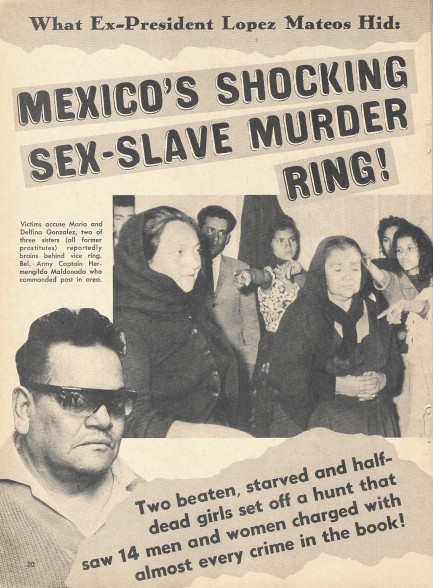 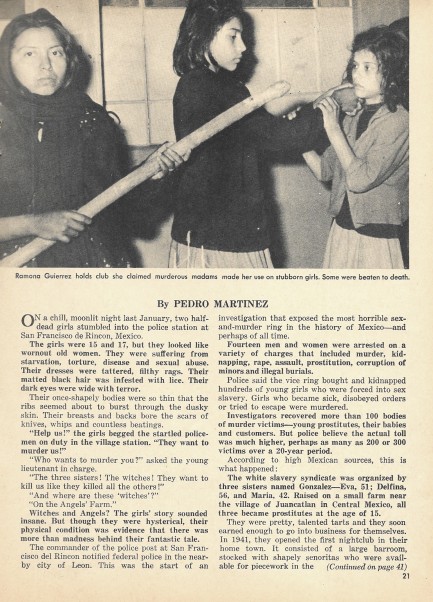 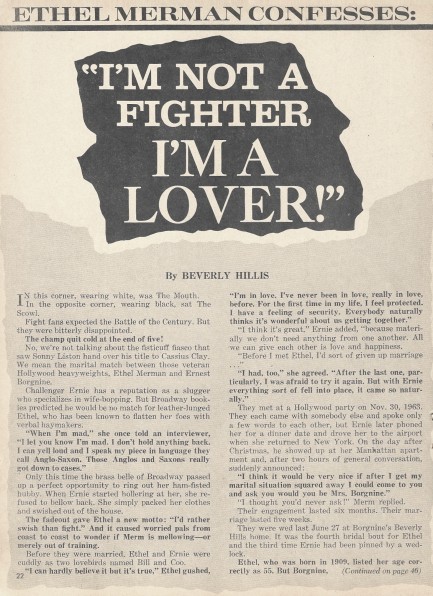 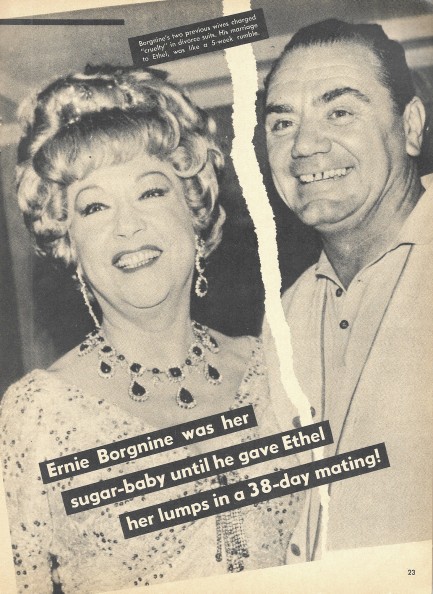 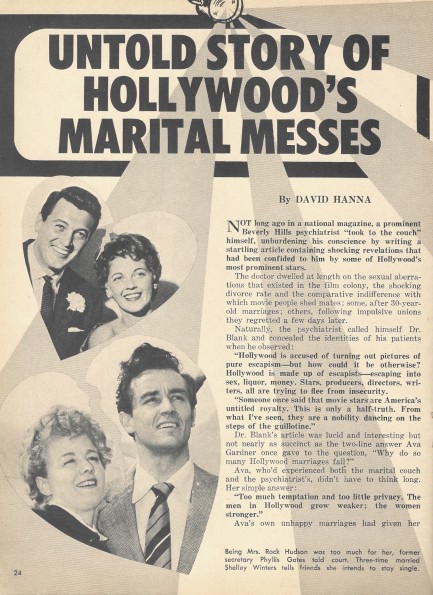 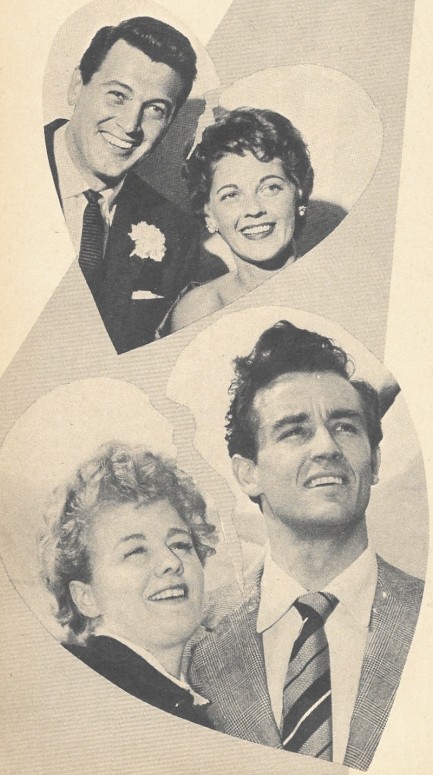 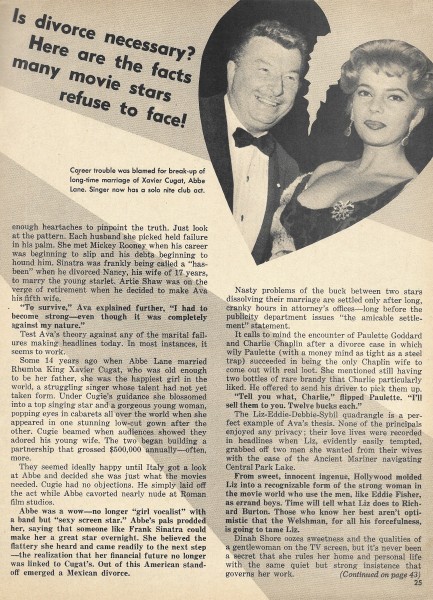 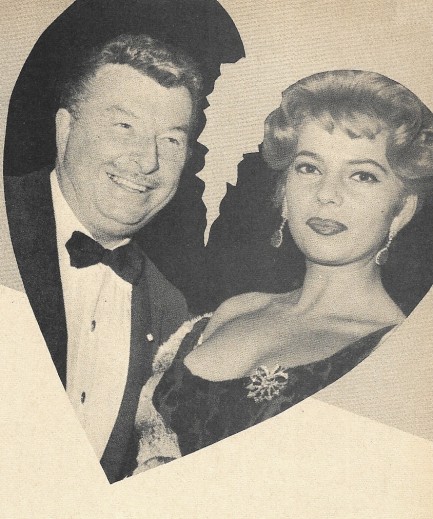 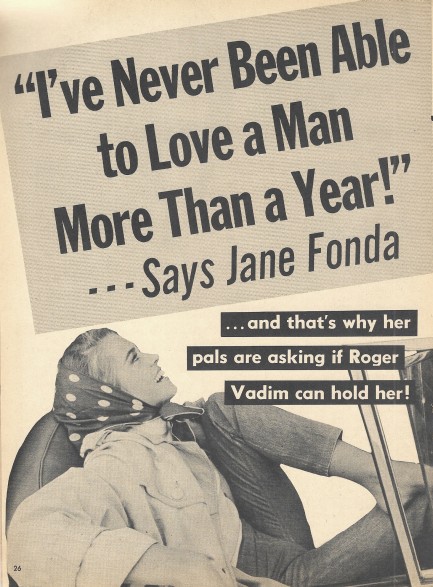 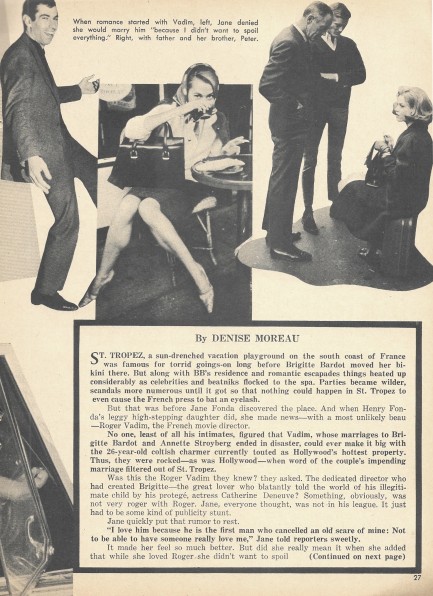 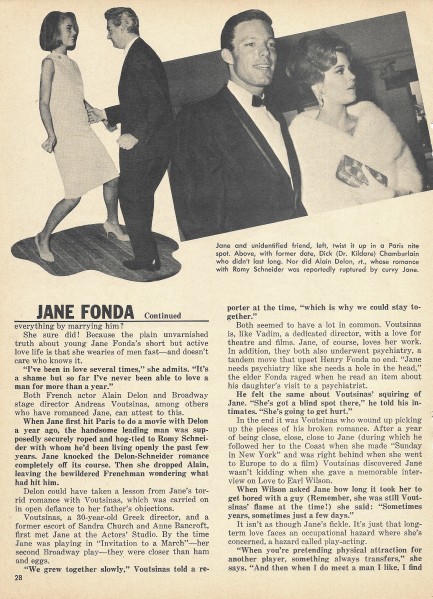 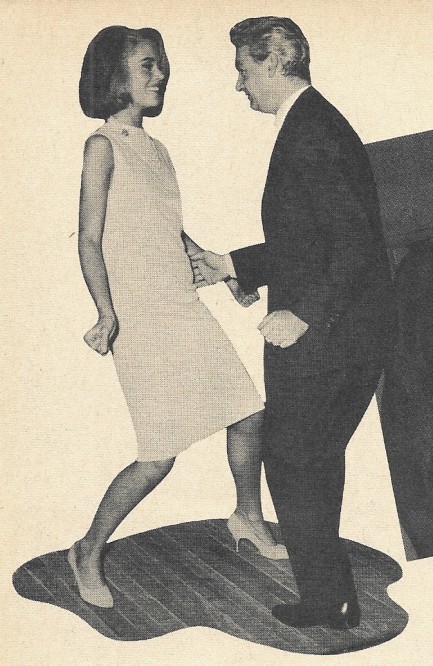 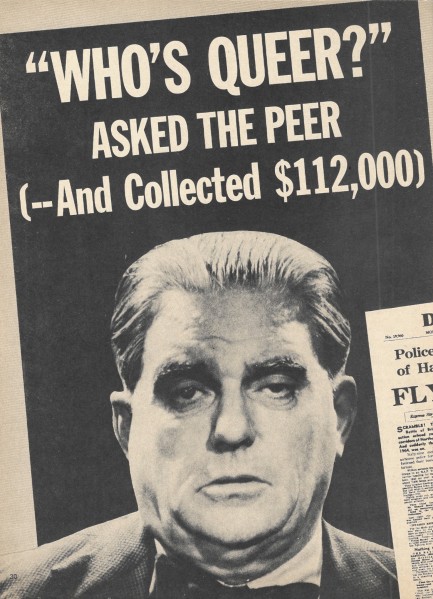 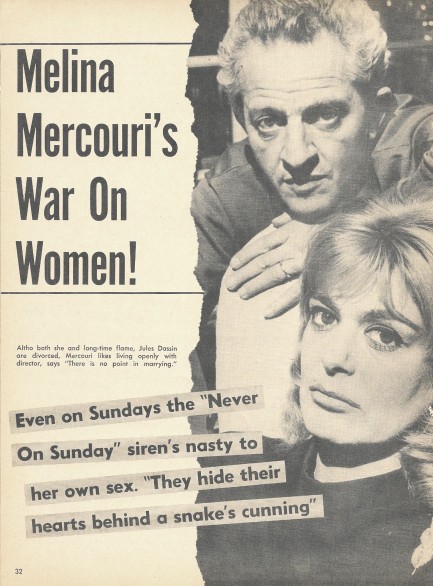 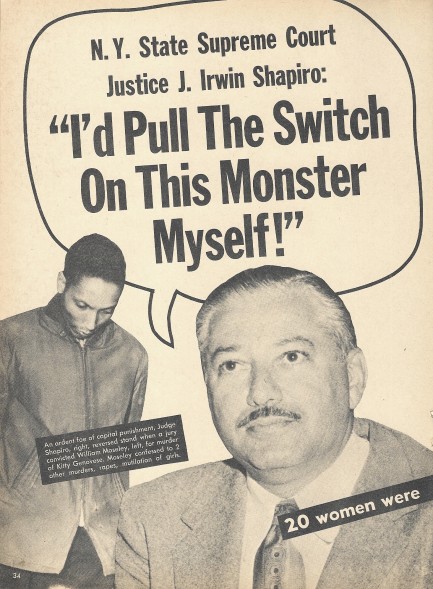 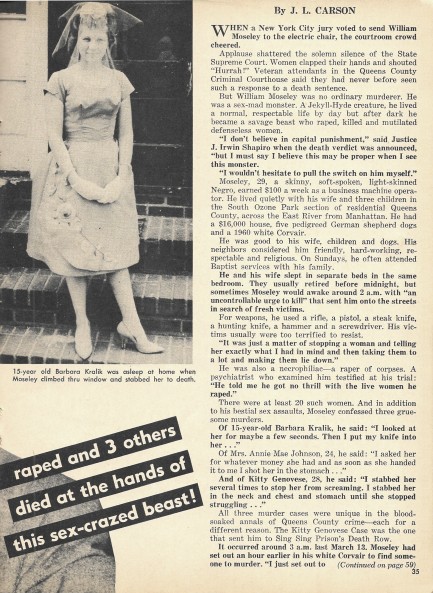 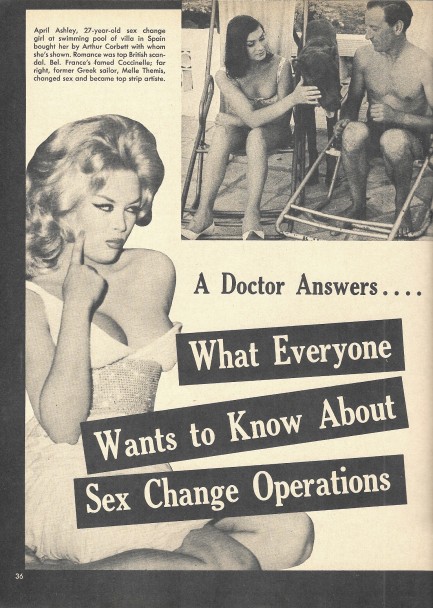 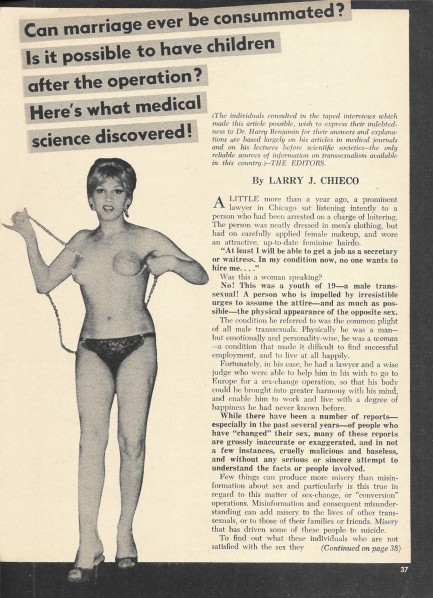 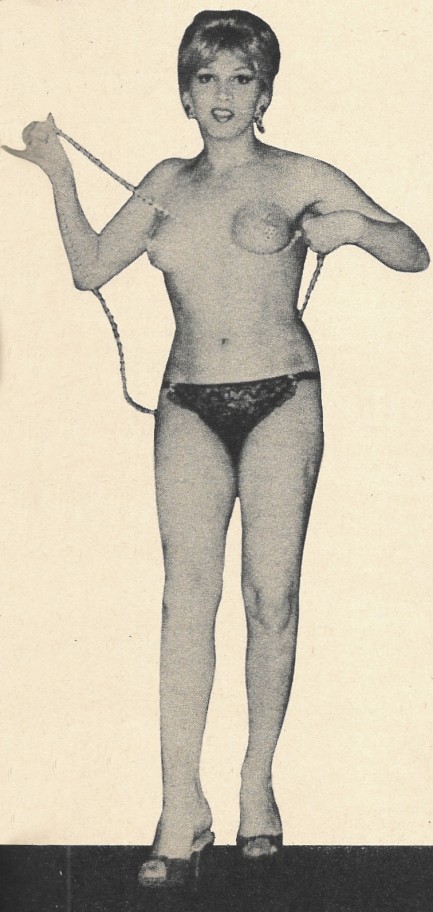 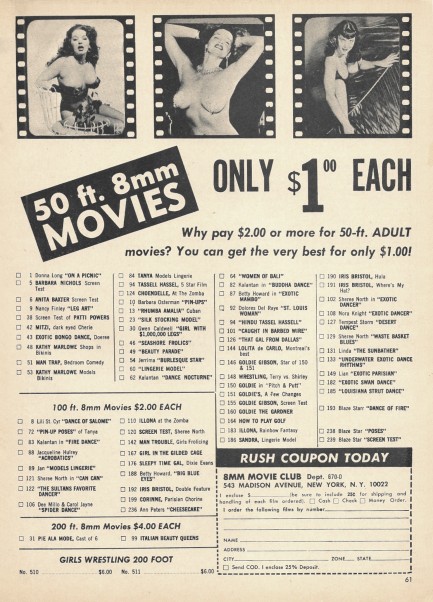
 Okay, my dear. Let's get you back indoors. You've provided Italy more than enough spank bank material for one day. 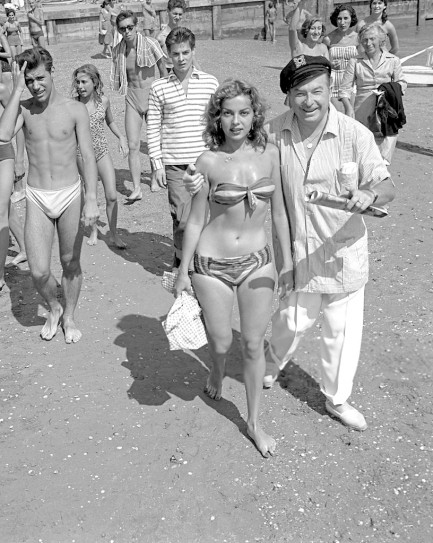
We recently showed you Abbe Lane on one of her album covers, but we've brought her back today because of this fun photo and the ones below. Lane was once deemed by Italian television authorities to be too sexy for broadcast. That's right—in Italy. So you can imagine the excitement when she donned this striped bikini for a photo shoot on the Lido in Venice, Italy during the summer of 1956. The proprietary arm belongs to her husband, Spanish bandleader Xavier Gugat. We think of the couple as the Beyoncé and Jay Z of their era, which is to say, Lane is waaaay too pretty for Cugat. She was also thirty-one years younger than him, which just goes to show what talent can do for a man: Xavier: You have inspired me, baby. I will write a song about you.
Abbe: You've already written me dozens, Xavier. All that cha-cha stuff is getting a little old.
Xavier: Music is just one of my abilities, cariño. Did I ever make you my authentic paella Valenciana with garrofó and rabbit? I almost became a chef, you know, but music beckoned.
Abbe: Men have cooked for me before. Yves Montand once made me a chocolate and pear soufflé. It was an exquisite grace note in a magnificently composed dinner, and that wasn't even really the dessert.
Xavier: Yes, that Yves. How urbane of him. How about I give you a purifying seaweed mask and a pedicure? I am a bit of an amateur aesthetician, and I love your feet.
Abbe: My skin—in case you haven't noticed—is perfect. Several men told me that today, and a cabana boy named Guido gave me a foot rub. You were snorkeling at the time.
Xavier: Grrr... I see. Well, I could paint your portrait. I am quite a good artist. I spent some time studying egg tempera at the Reial Acadèmia Catalana.
Abbe: I could never sit still that long again. Marcello Mastroianni painting me nude last year was quite enough. Day after day, hour after hour in that... well, frankly provocative pose he wanted. You were on tour, but I knew you wouldn't mind.
Xavier: Is that so? Well, fine, but I was at his house just a month ago. Why did he not show me this painting?
Abbe: I don't know. It's hanging right in his bedroom. So he tells me.
Xavier: *sigh* No meal, no skin care, no song. I guess I am just an old man unable to impress you any longer. When we get back to the villa I will simply take out the garbage, then finish reading that book I was—
Abbe: Take out the garbage? Oh, sweetheart. Tell you what—you do that and I'll put on the g-string and thigh-high boots you like and meet you in the bedroom.
The lesson from that day in Venice is that, for a wife, the ultimate turn-on is a husband who's willing to do chores. Cugat spent eleven years with Lane before they finally divorced in June 1964. She was married again before the year was over, which was a pretty fast rebound and remarriage even for Hollywood. Meanwhile, a few years later Cugat married Spanish singer and dancer Charo, who was his junior by fifty-one or forty-one years, depending on who you believe. Either way, music, cooking, and even chores are all fine, but maybe Cugat's real talent was for bedazzling younger women.
 Not only was she explosively sexy, but her voice could blow you away. 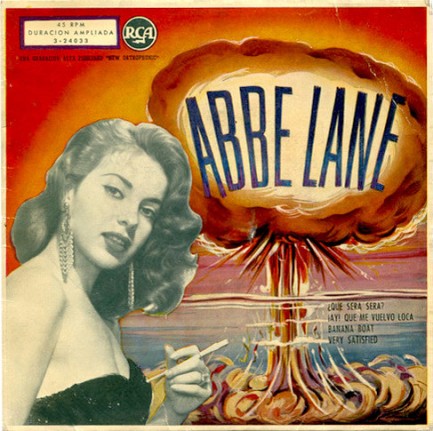
We love this nuclear themed 45 sleeve for an Abbe Lane four song disc, which we guess is titled simply Abbe Lane. It came from RCA Española and was released in Spain in 1958 with the offerings: “Que será será,” “¡Ay! Que Me Vuelvo Loca,” “Banana Boat (Day-O),” and “Very Satisfied.” All four songs are easy to sample online, so give them a whirl if you wish.
The rear sleeve text is fun. It says: Abbe Lane is without a doubt one of the most popular and applauded voices of the current musical moment. All her performances are hits and the songs she sings come to us covered in a rhythm and color that make them even more seductive.
Without a doubt, the secret of her success lies in herself, in her warm voice, in her exquisite way of conveying the message of her music to the listener, in her magnetic figure and great physical attractiveness.
In this recording, Abbe Lane sings in English and Spanish, interprets two calypsos, a fashionable rhythm that has come to dispute the primacy enjoyed by the much-discussed “rock and roll,” and two melodies that will be popular through the warm voice of the artist pampered by the public and critics worldwide: Abbe Lane.
The promotional staff at RCA Española might have loved Lane, but they couldn't spell. They open the third paragraph by calling her “Abre,” instead of Abbe. That amused us. We also like how, according to the front office brains, calypso was supplanting rock and roll. Really? Well, it turned out to be a marathon, not a sprint. We have a bonus shot of Lane below, for your viewing pleasure.
 Just when you thought it was safe to go back in the water. 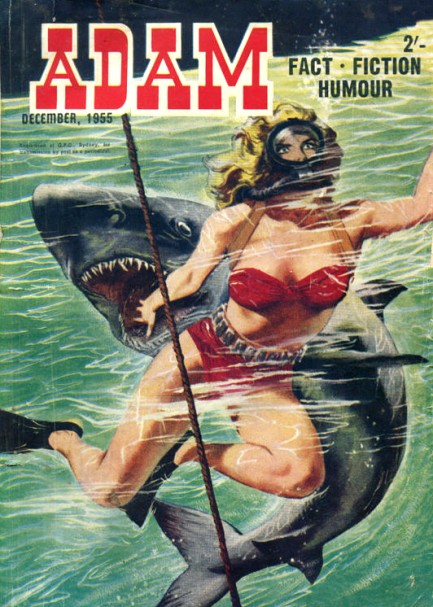
We thought the 1952 issue of Adam we scanned a little while back was fragile. It has been surpassed by the above pastry crust-like issue from this month in 1955, which we barely got back into a plastic sleeve (reasonably) intact. In case you ever wondered why we stick with ’70s issues, that's the answer. But the older mags often come bundled in lots with the newer ones. Anyway, it's nice, with a brilliant cover illustration of a scuba diver and a shark, not the first time Adam has gone with this shark theme. The art is meant to reference one of the tales inside, Jonathan Edwards' aquatic adventure “Deep Water Hero,” about a trio of fortune hunters that go diving on a shipwreck and run into shark trouble. There are lots of shark tales in these magazines, one every few issues. This one is probably the best we've read. In addition you get rare photos of Abbe Lane and various unknown models. We have eighteen scans below, sixty other issues in the website, and more from Adam to come. 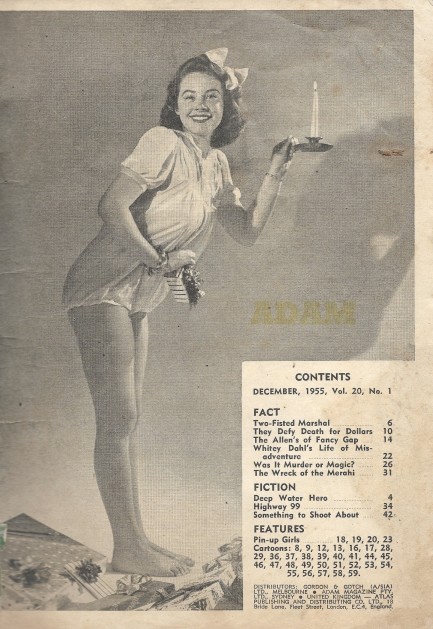 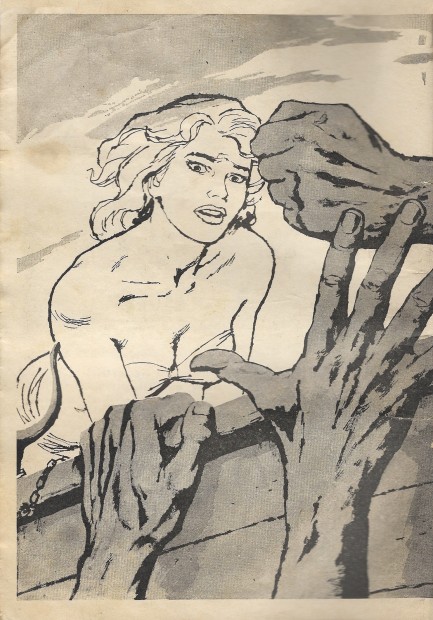 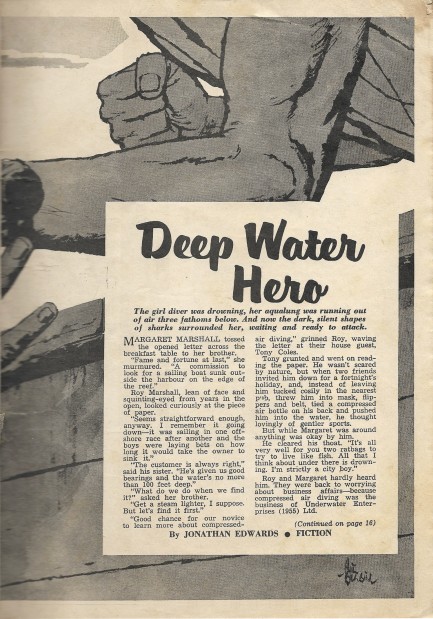 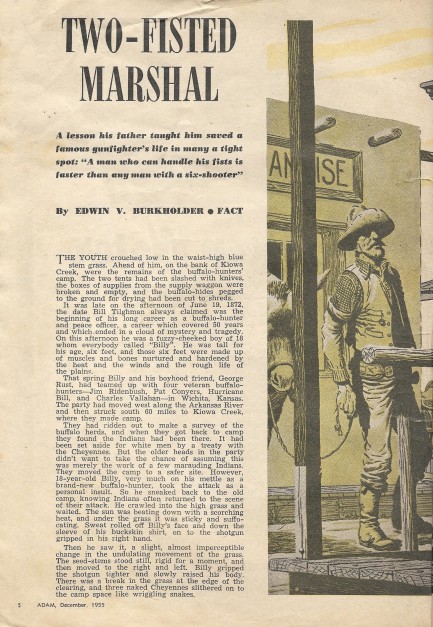 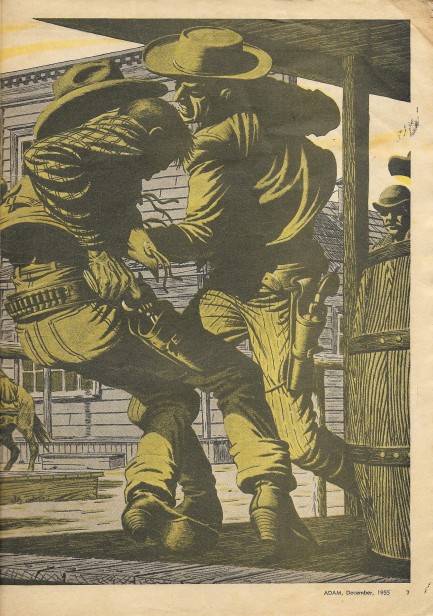 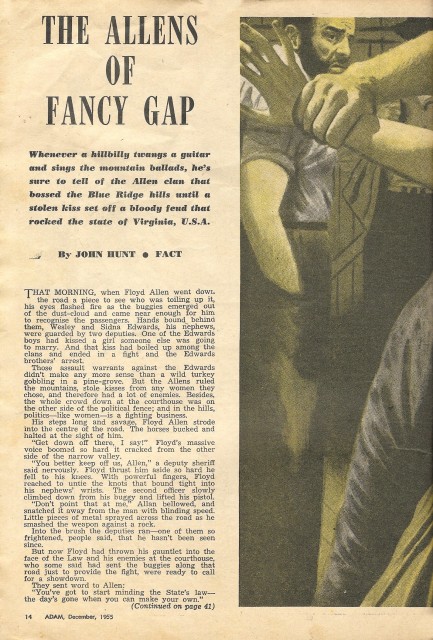 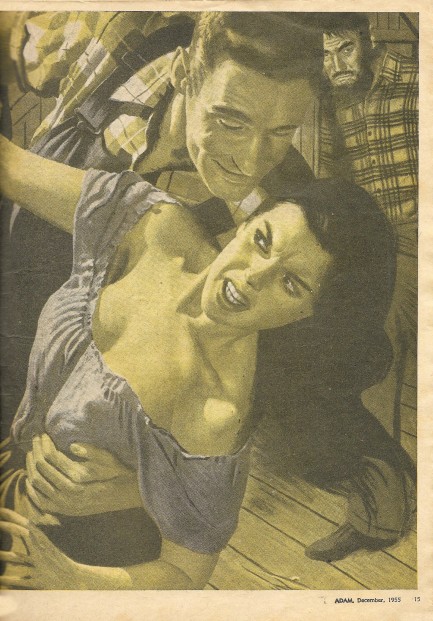 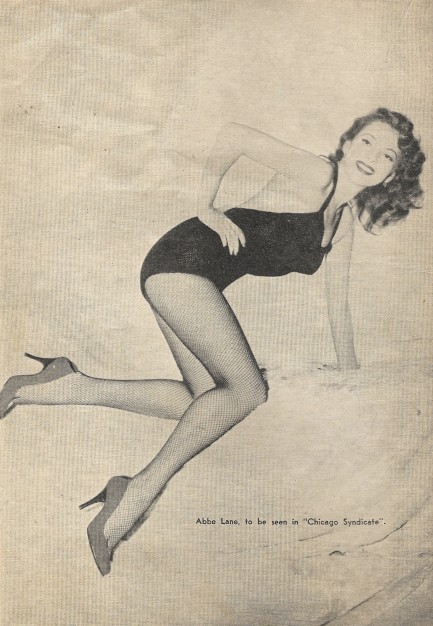 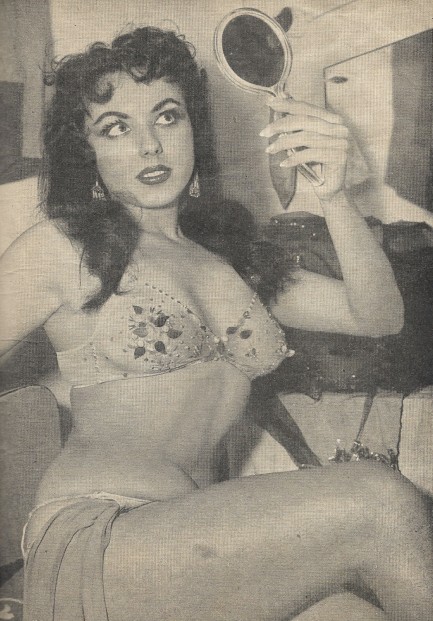 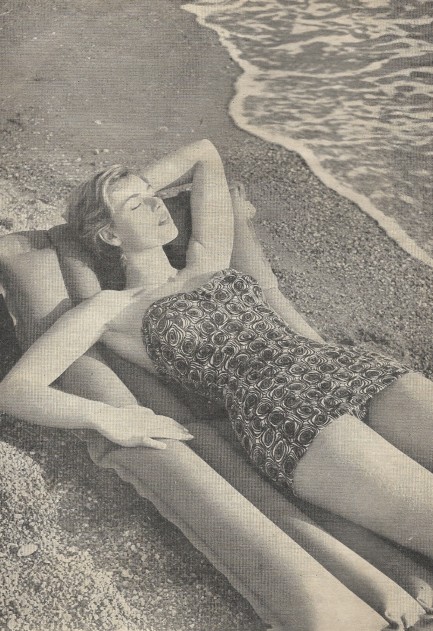 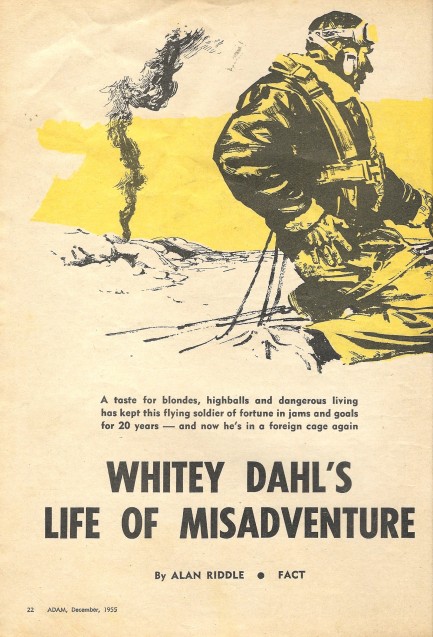 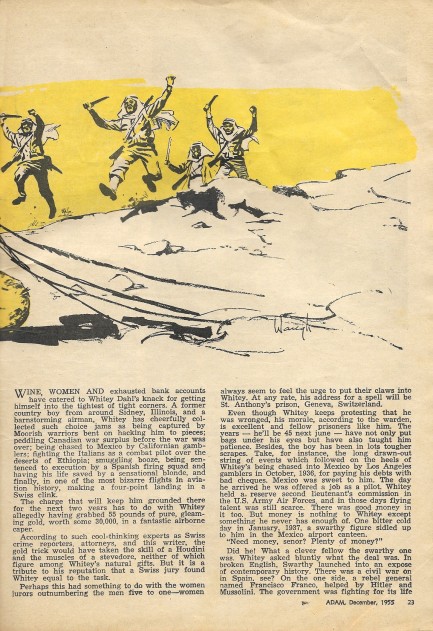 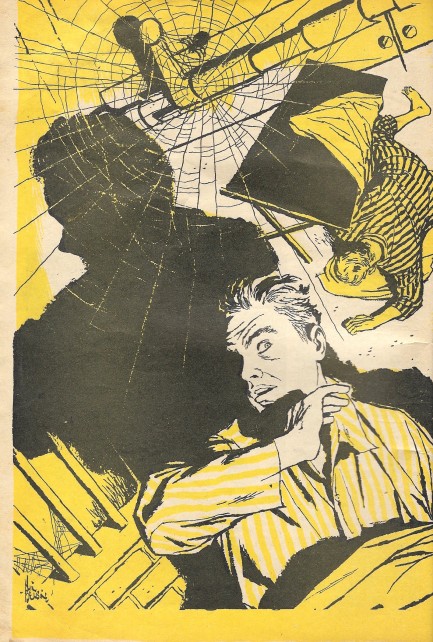 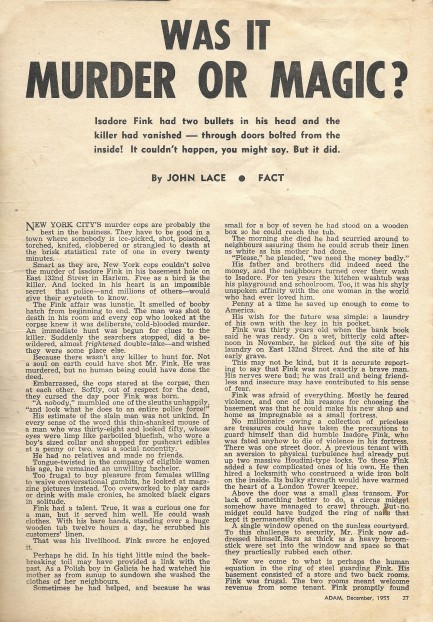 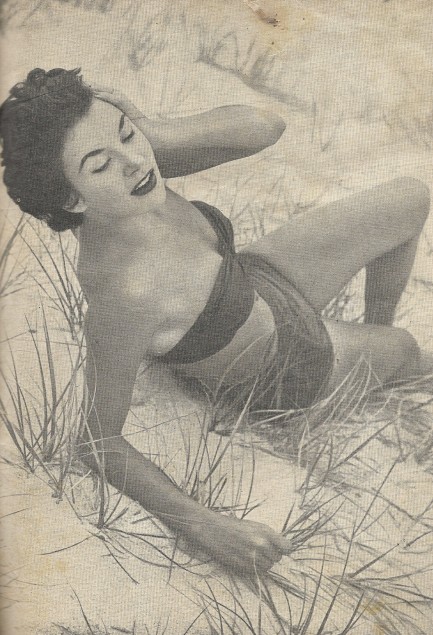 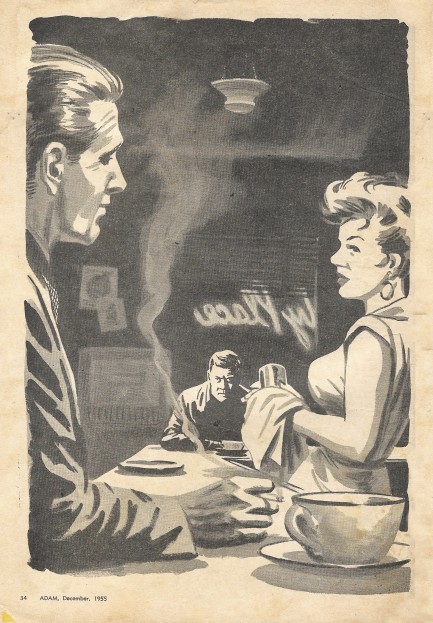 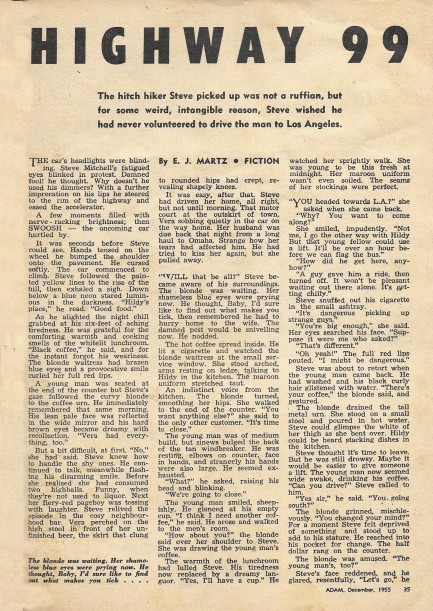 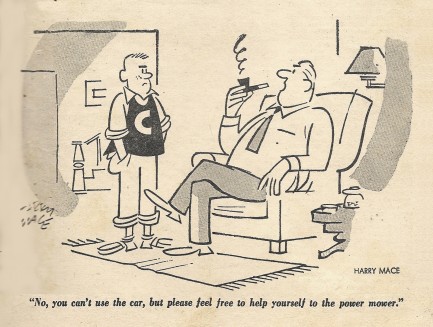
 American singer gets booked for special engagement Down Under. 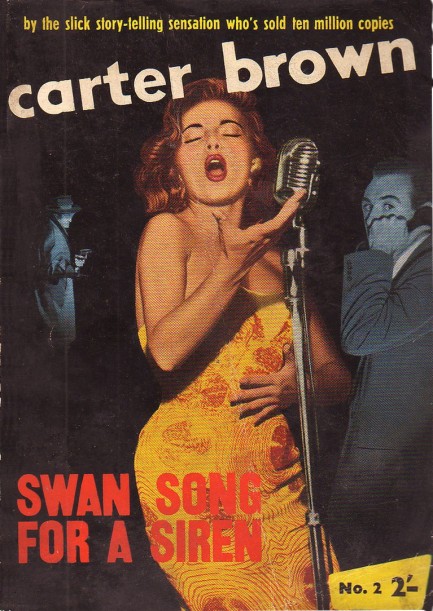
We love documenting the appropriations of celebrities by Horwitz Publications. This time the company snares U.S. nightingale Abbe Lane for its 1955 edition of Carter Brown's Swan Song for a Siren. You see the original photo they worked with below, which also features Lane's husband Xavier Cugat in the left background, erased by Horwitz's graphics guru and replaced by a man with a gun. The company would reprint this title in 1958 with Senta Berger on the cover, because once you get a taste for kidnapping celebrities you never stop. You can see that edition here. And if you want to see more examples of celebrity theft click the Horwitz keywords below.
 Crime magazine gives readers the gifts of death and mayhem. 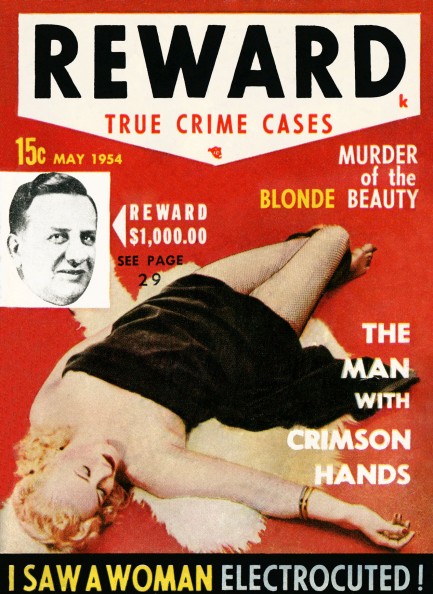
Produced by the J.B. Publishing Corp. of New York City, Reward was a true crime magazine, another imprint designed to slake the American public's thirst for death and mayhem. Inside this May 1954 issue the editors offer up mafia hits, Hollywood suicides, domestic murder, plus some cheesecake to soothe readers' frazzled nerves, and more. The cover features a posed photo of actress Lili Dawn, who was starring at the time in a film noir called Violated. It turned out to be her only film. In fact, it turned out to be the only film ever acted in by top billed co-star William Holland, as well as supporting cast members Vicki Carlson, Fred Lambert, William Mishkin, and Jason Niles. It must have been some kind of spectacularly bad movie to cut short all those careers, but we haven't watched it. It's available for the moment on YouTube, though, and we may just take a gander later. Because Reward is a pocket sized magazine the page scans are easily readable, so rather than comment further we'll let you have a look yourself. 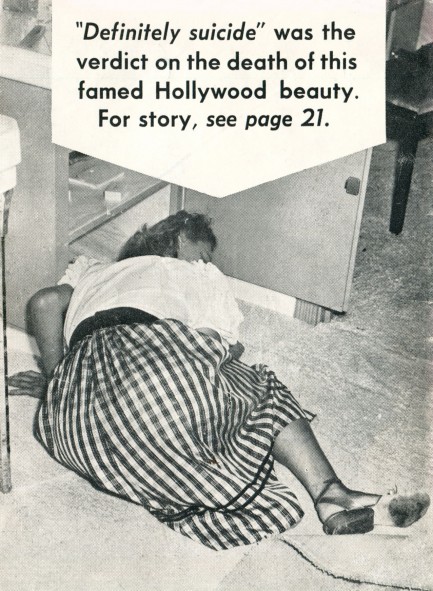 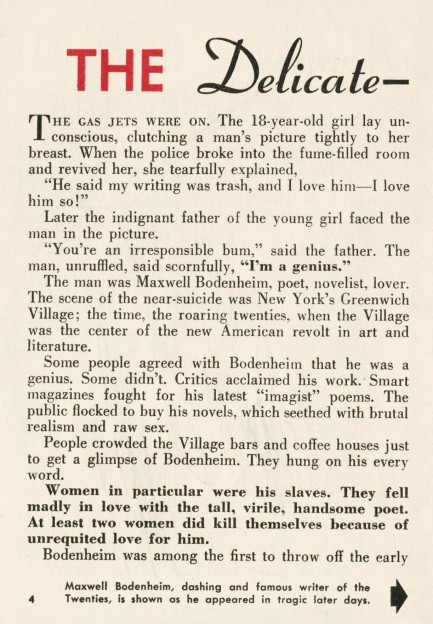 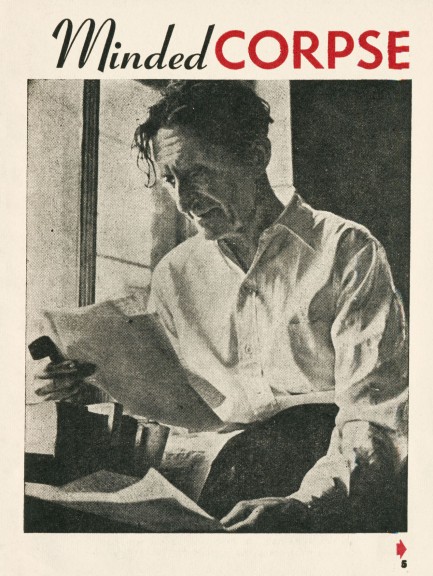 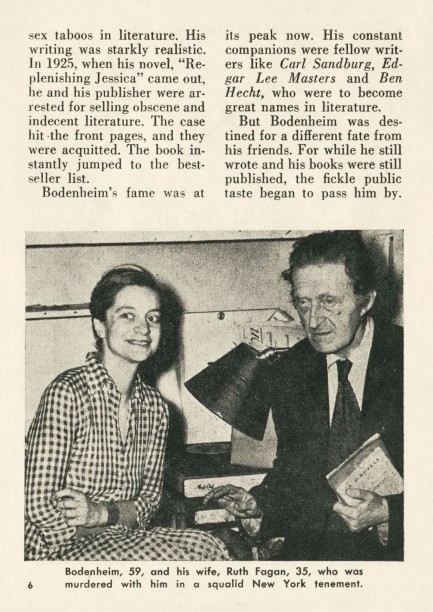 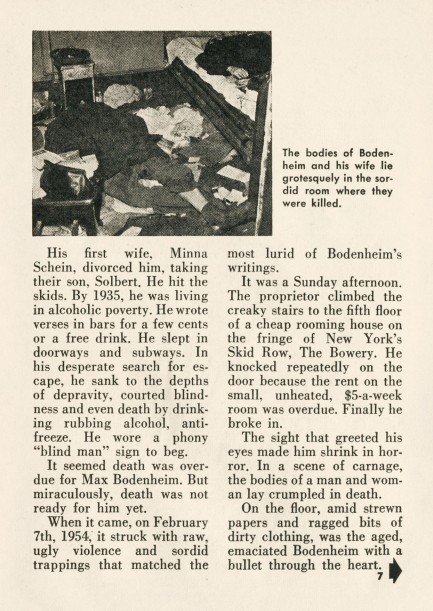 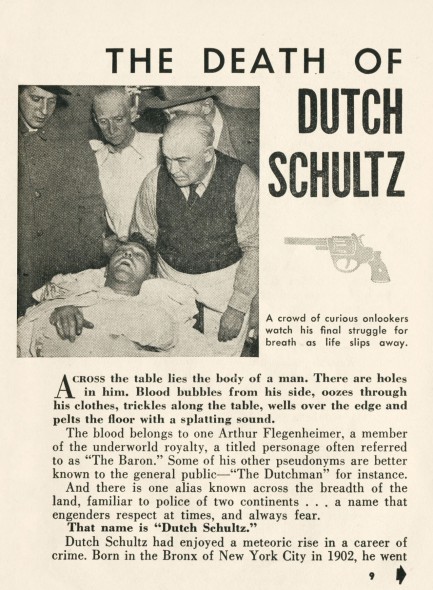 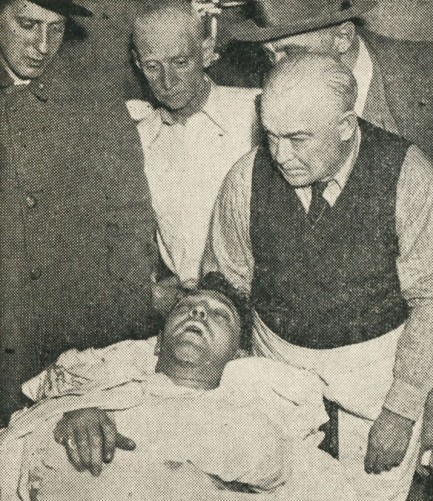 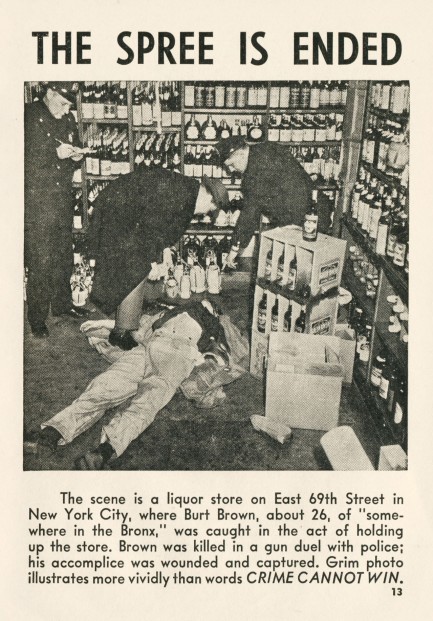 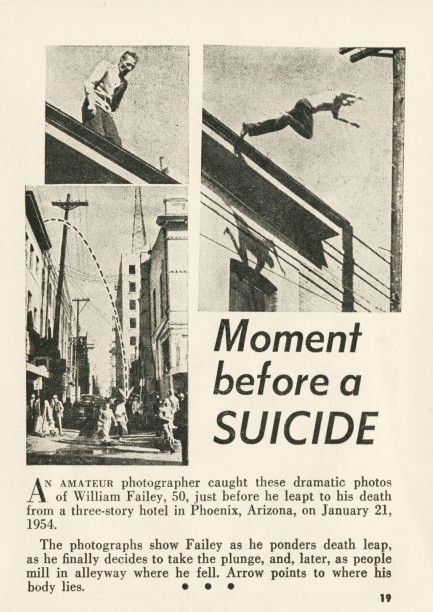 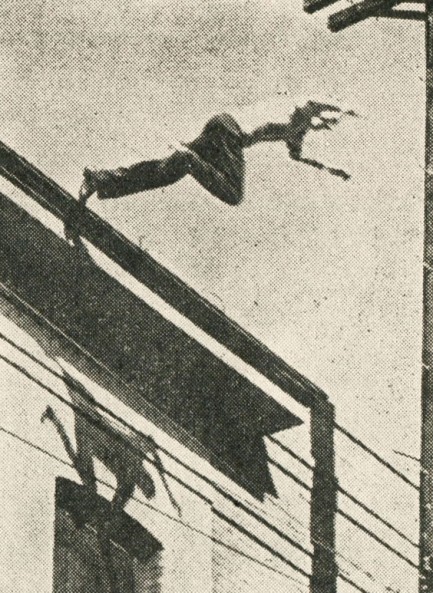  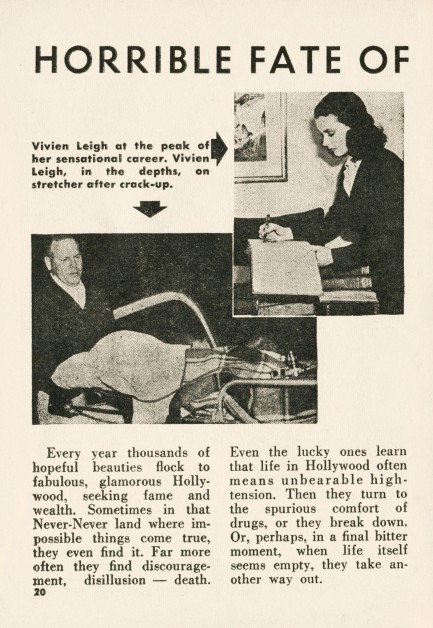 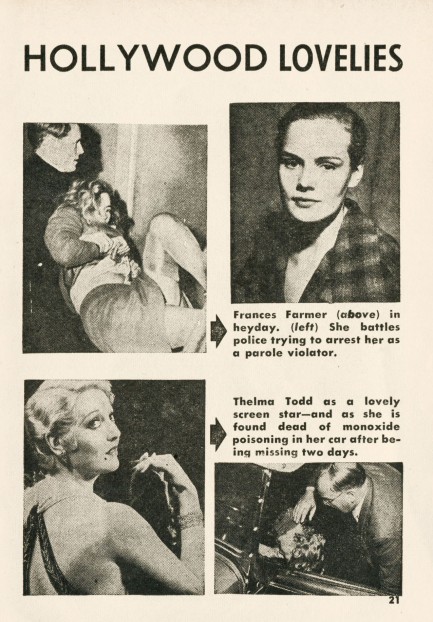 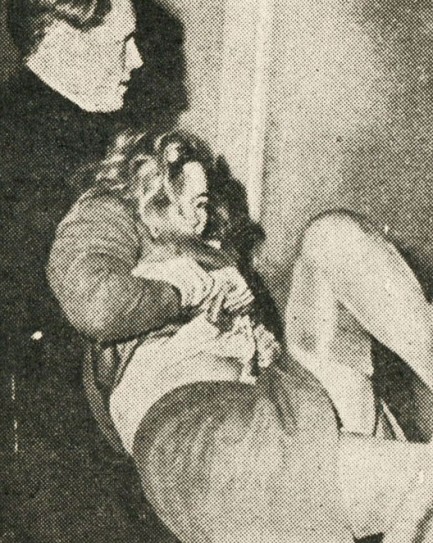 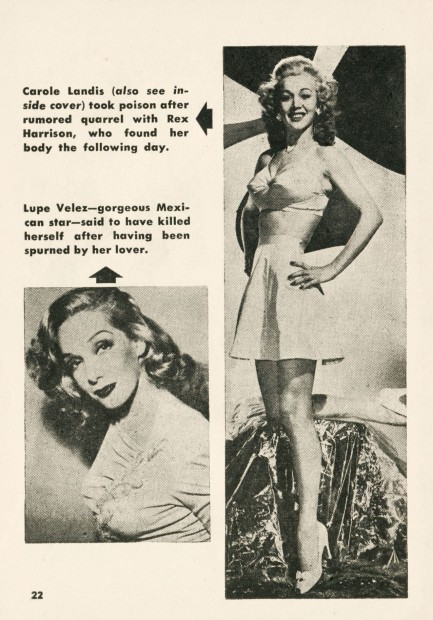 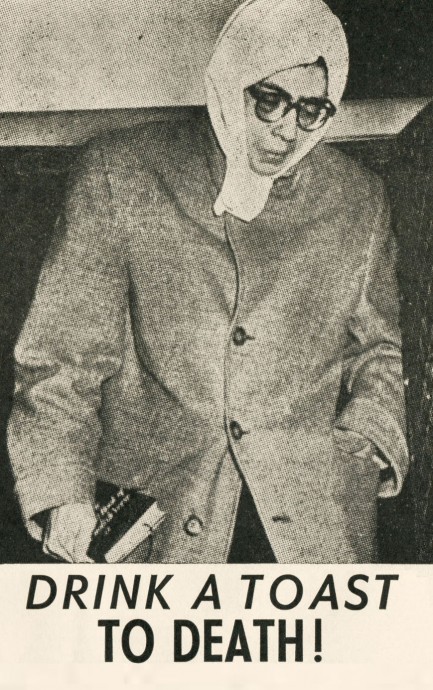 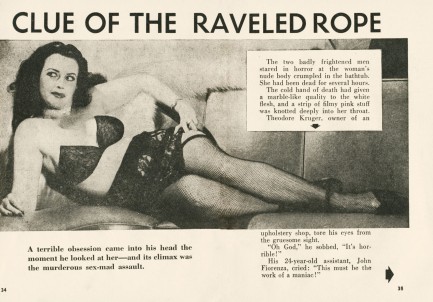 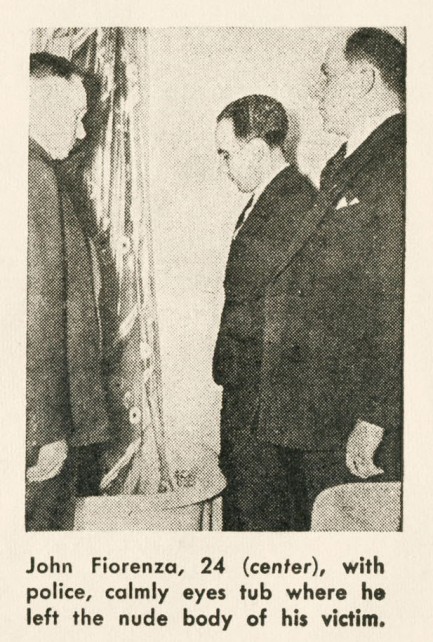 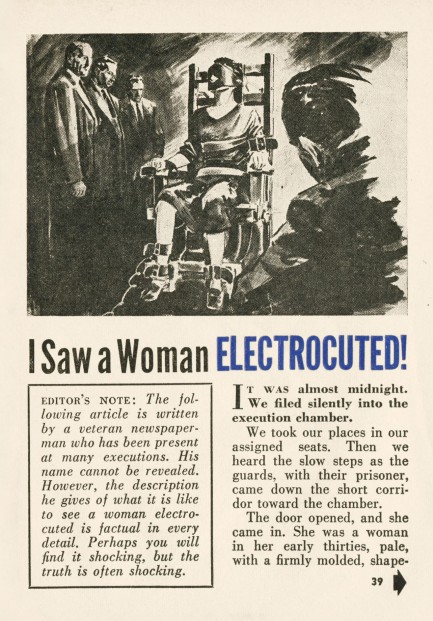 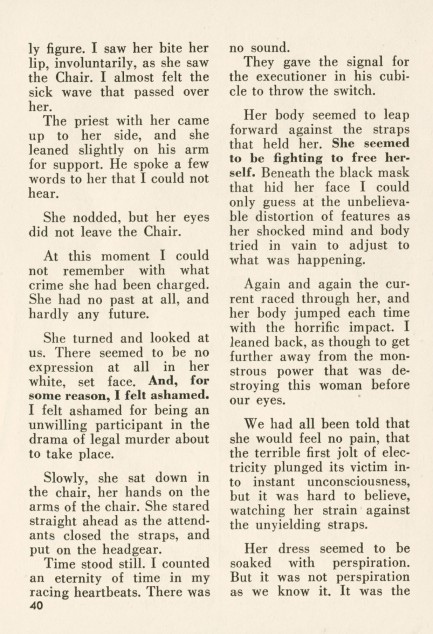 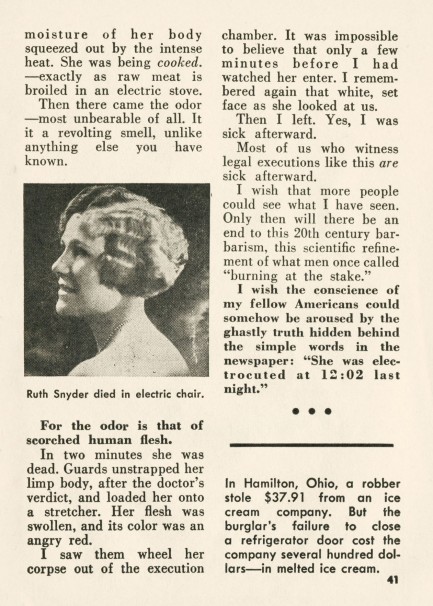 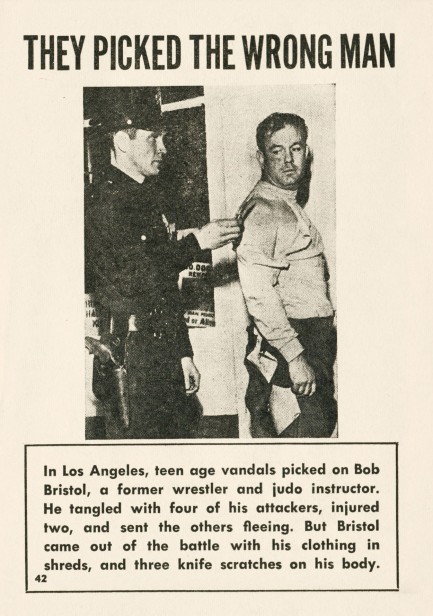 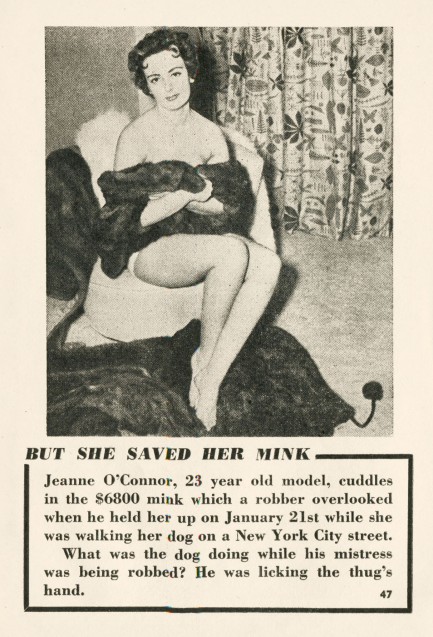 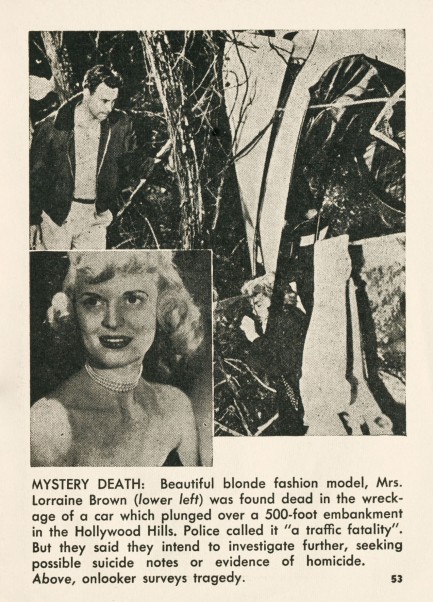 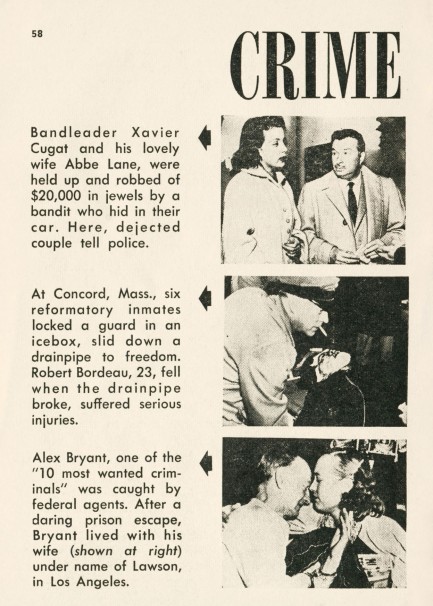 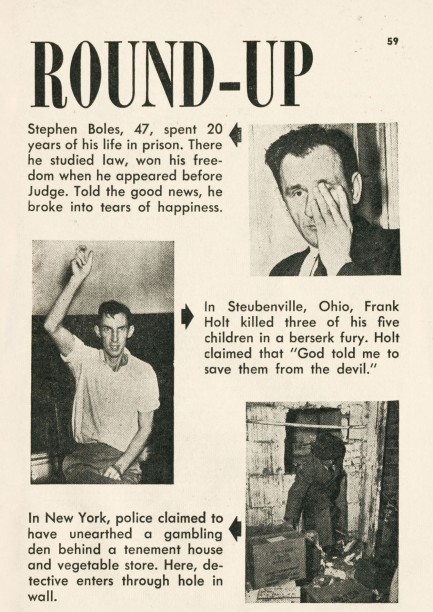 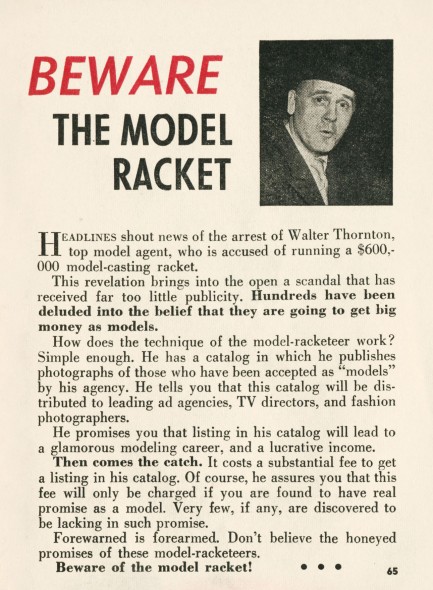 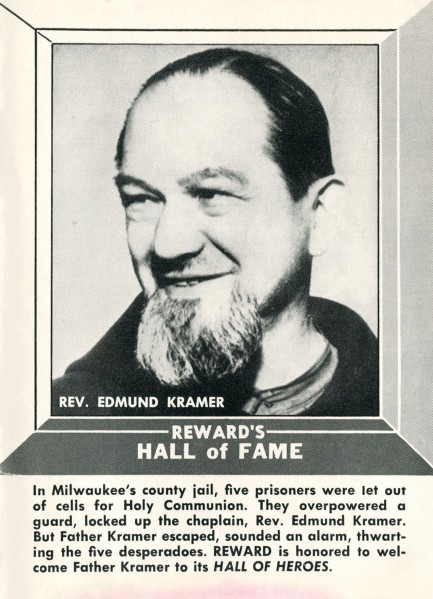 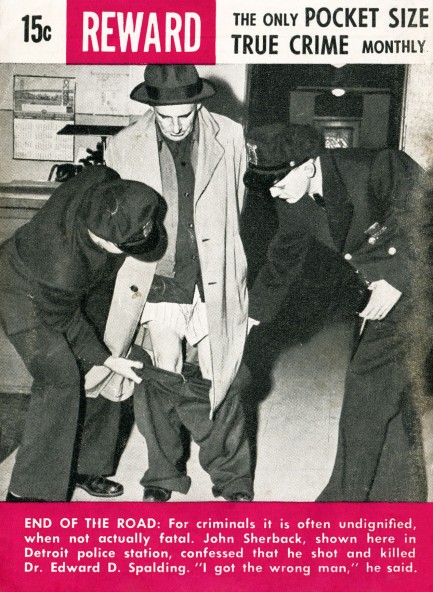
 Abbe Lane wiggles it just a little bit. 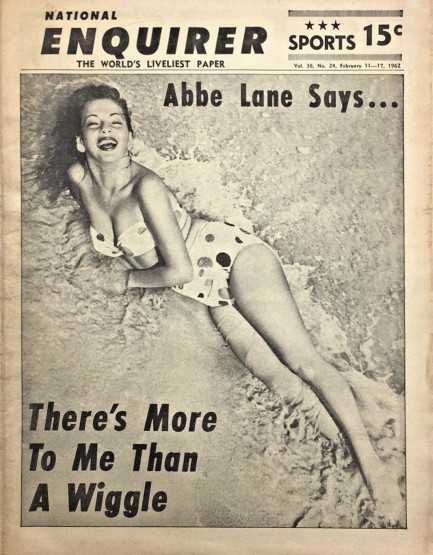
When we saw this National Enquirer cover our first thought was: “She was famous for wiggling?” We did a search and found that famed singer Abbe Lane was indeed known for her shimmy, which inflamed imaginations to dangerous levels back in February 1962, when this Enquirer hit newsstands. Check out this bit from the Gil Brewer pulp thiller Wild: She turned and walked into the house, through the doors. [snip] Her walk was lusciously lazy from behind, mindful of Abbe Lane crossing the platform for a bit of cha-cha-cha. So yes, she was famous for her moves. And thanks to the magic of technology we found footage of her in action. It's pretty sedate by today's standards, but still worth watching. We have more nice Lane photos you can see, if you're interested. Full disclosure: they don't wiggle, but they still look nice.
 Yesterday seems so very far away. 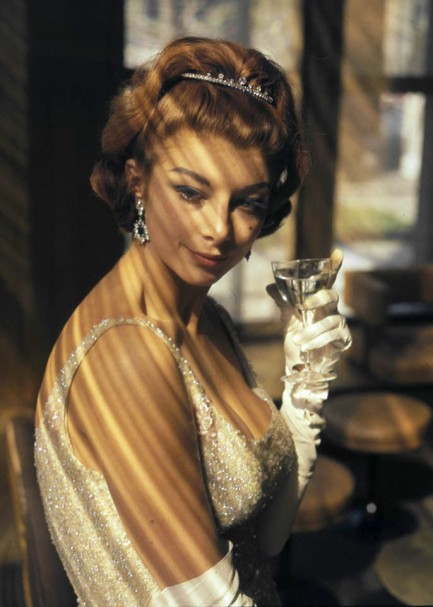
American singer Abbe Lane, née Abigail Francine Lassman, lurks in shadow and light in this very noirish photo made during the 1950s when she was at the height of her fame. She became a star while only twenty or so and is still around today at the tender age of eighty-three. We recently shared several fun album covers featuring her and her husband Xavier Cugat and you can see those here.
 Musically talented but not particularly handsome? No worries. Put your hot wife on your album covers. Spanish bandleader Xavier Cugat and his wife, singer Abbe Lane, were one of the most famous musical couples in the world during the 1950s and early 1960s, performing live together and releasing albums. These four Cugat album sleeves featuring Lane as the cover model evoke pulp fiction and film noir rather nicely, we think. Also, they kinda make us want to dance.
 Who were the people behind this magazine? They don't offer many clues. 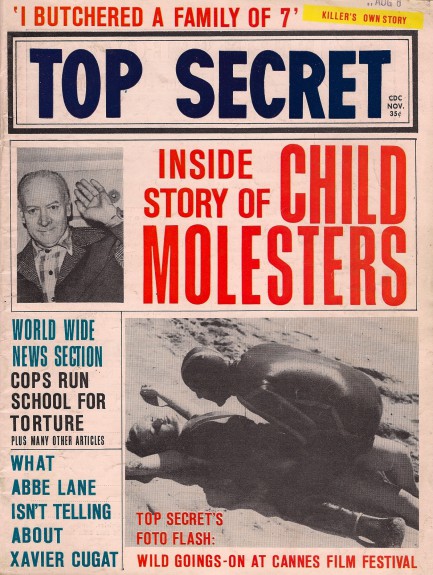
Top Secret fashioned itself a top tier tabloid, but one thing we’ve never liked about it is an inferior printing process that makes its interior images look like cheap dot matrix. We can’t tell you who to blame for that, though, because Top Secret was so secret it didn’t bother with masthead credits. At least not in the issues we’ve bought. Writers get by-lines, but editors and publishers do not so much as give a hint of their identities. Hell, our issues don’t even have publication dates, but we've discerned this one is from November 1964. Well, the backers might have been incognito but the methods were nothing unusual. One writer digs up dirt on Xavier Cugat and Abbe Lane, another tells the story of mass killer Jose Rosario Ramirez Camacho, another contributor delves into Tuesday Weld’s personal life, and a U.S. “heroin epidemic” is pinned on Chinese plotting to undermine democracy. Of special note, there’s a photo of Pamela Green (panel 18), whose weird transformation into Princess Sonmar-Harriks we shared a while back. Also, the photo of French actress Astrid Caron (in the bikini) looks familiar. That’s because we saw it in a different tabloid—this issue of Inside Story—unattributed and used for a piece about suntan lotions. It shows how these magazines used handout photos for whatever purposes they saw fit. Also, Top Secret publishes an open letter to America entitled A Homosexual Pleads—Why Don’t You Leave Us Alone! You’d be forgiven for expecting something ridiculous from a mid-century tabloid, but this piece credited to an anonymous writer is smart and serious. It enumerates the injustices gay men face, from housing discrimination to military disenfranchisement, and feels like it could have been written yesterday. Scans below. 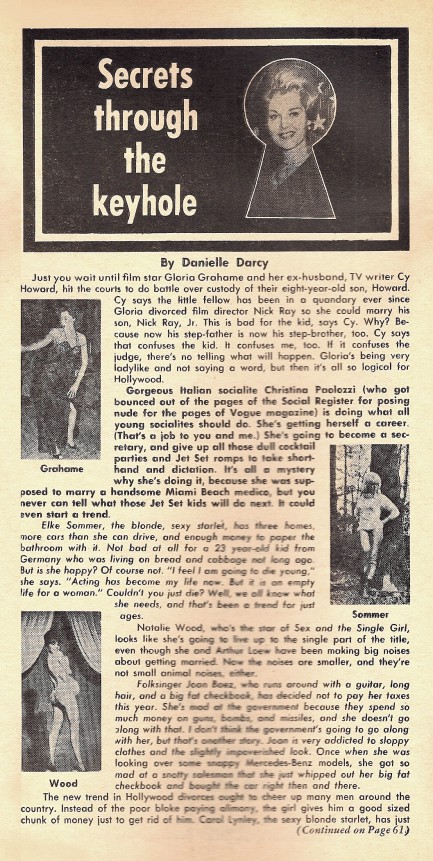 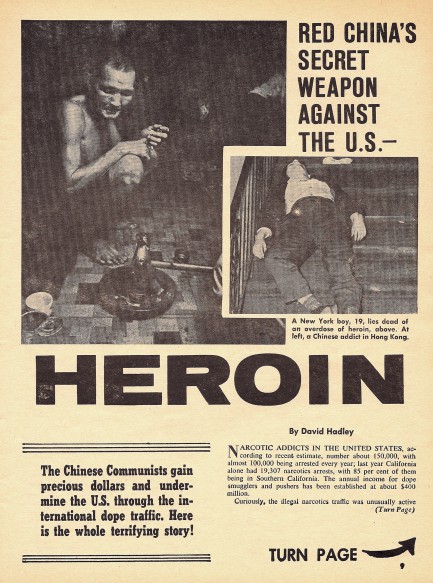 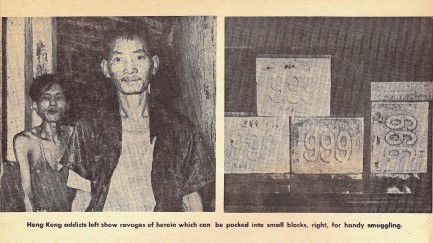 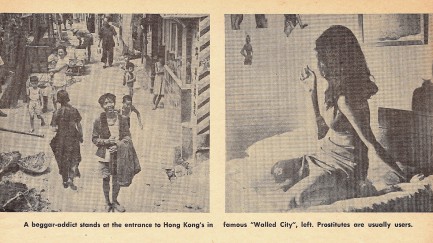 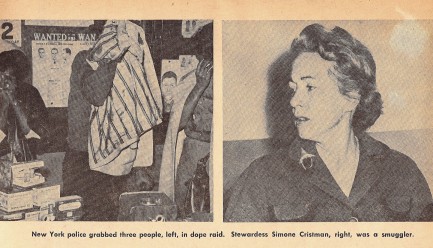 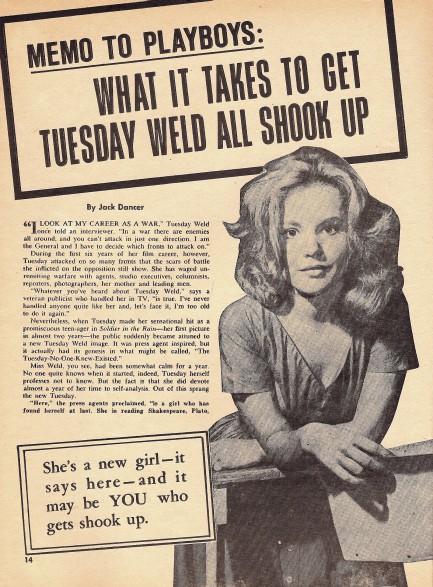 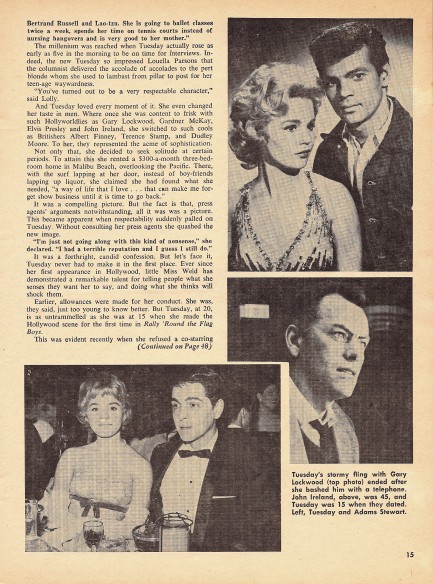 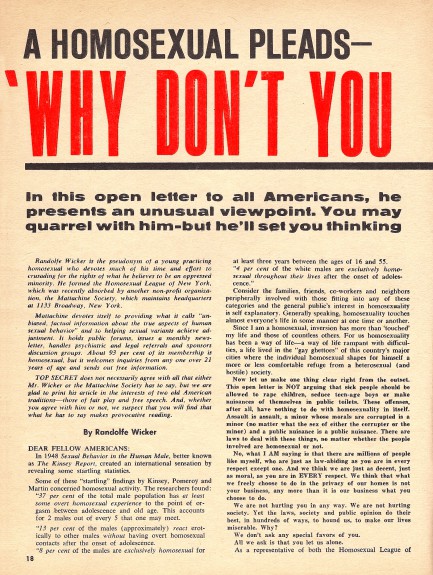 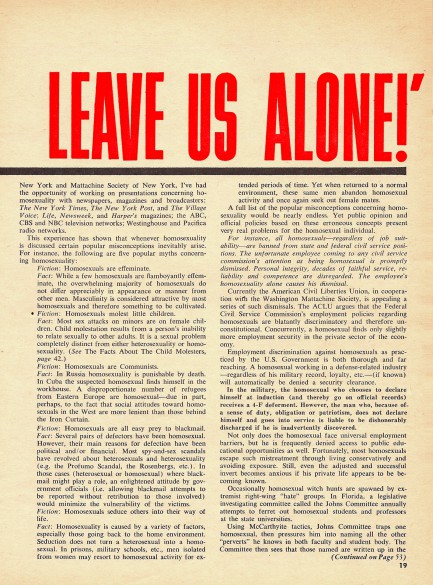 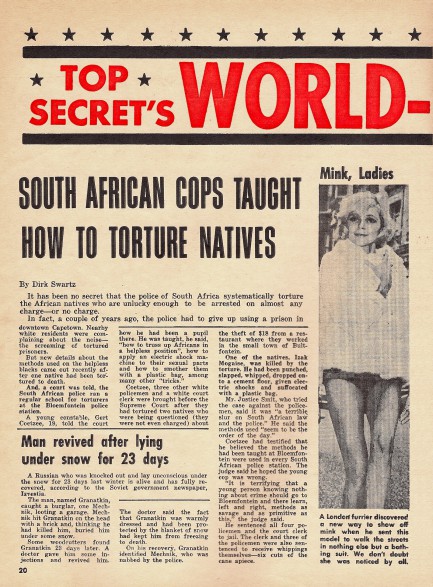 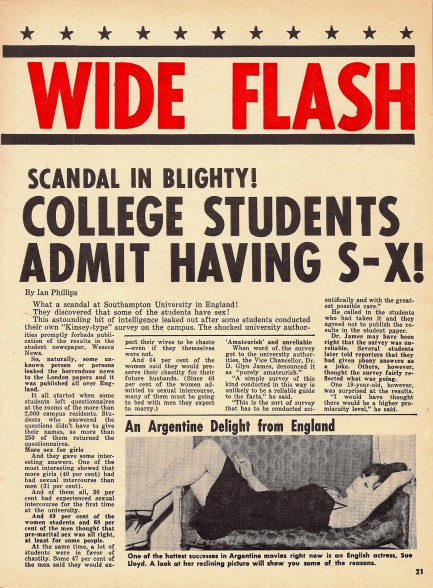 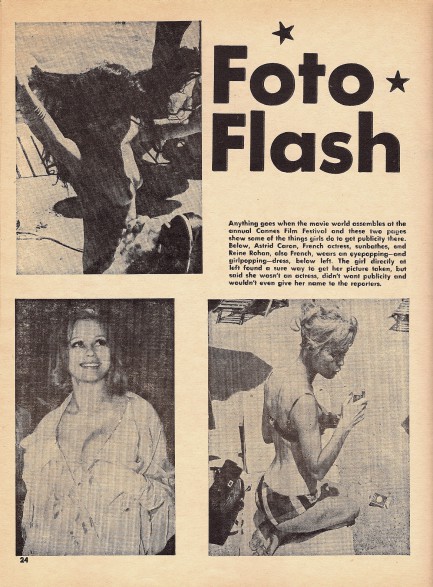 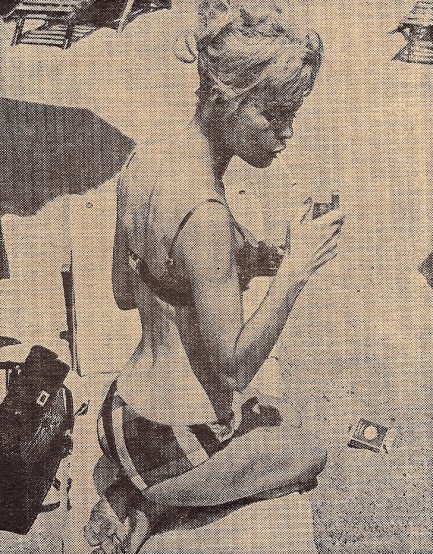 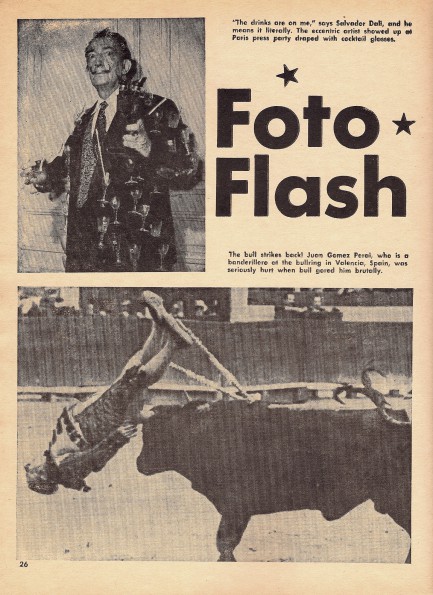  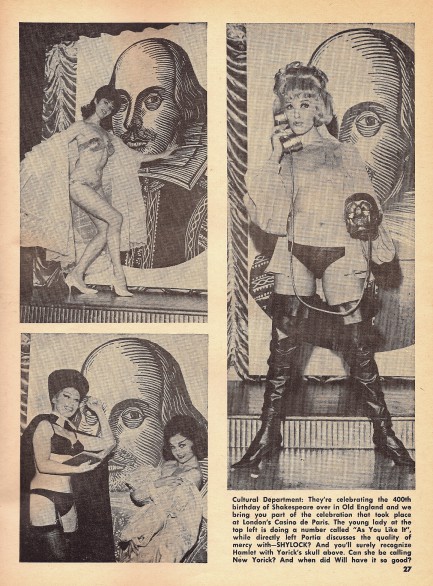 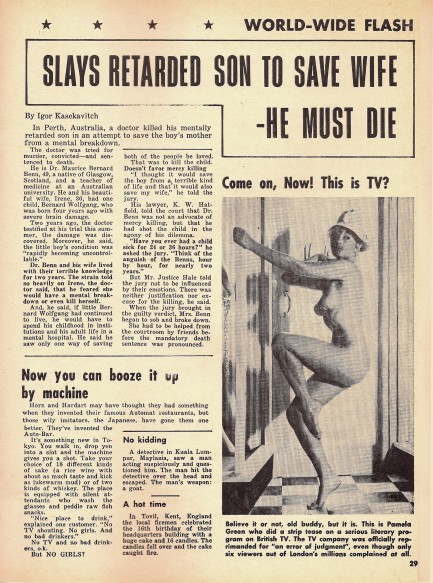 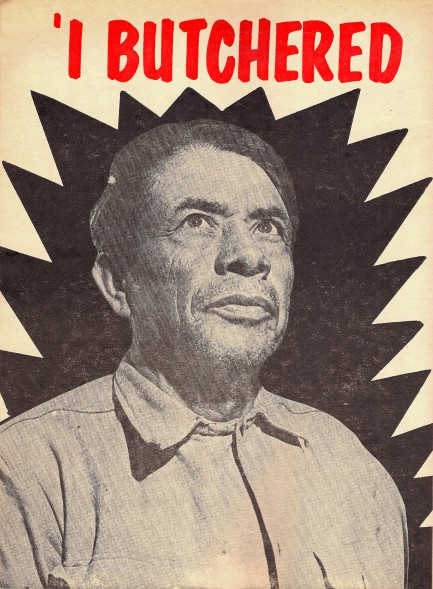 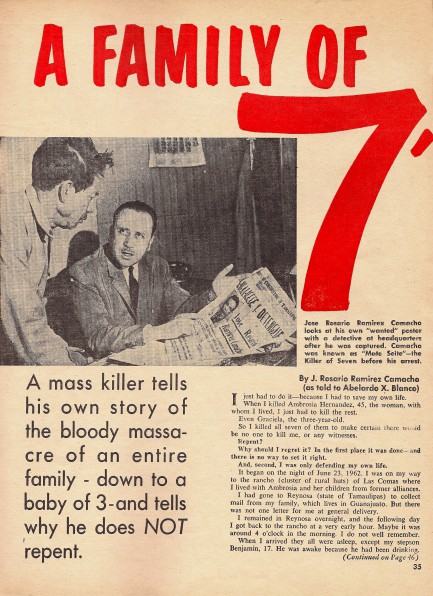 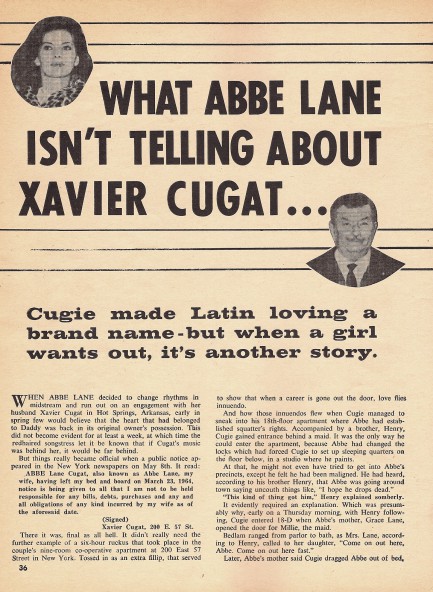  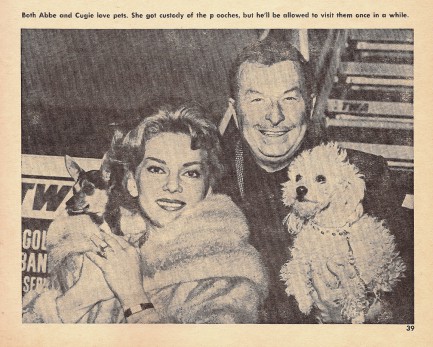

|
 |

The headlines that mattered yesteryear.
2003—Hope Dies
Film legend Bob Hope dies of pneumonia two months after celebrating his 100th birthday. 1945—Churchill Given the Sack
In spite of admiring Winston Churchill as a great wartime leader, Britons elect
Clement Attlee the nation's new prime minister in a sweeping victory for the Labour Party over the Conservatives. 1952—Evita Peron Dies
Eva Duarte de Peron, aka Evita, wife of the president of the Argentine Republic, dies from cancer at age 33. Evita had brought the working classes into a position of political power never witnessed before, but was hated by the nation's powerful military class. She is lain to rest in Milan, Italy in a secret grave under a nun's name, but is eventually returned to Argentina for reburial beside her husband in 1974. 1943—Mussolini Calls It Quits
Italian dictator Benito Mussolini steps down as head of the armed forces and the government. It soon becomes clear that Il Duce did not relinquish power voluntarily, but was forced to resign after former Fascist colleagues turned against him. He is later installed by Germany as leader of the Italian Social Republic in the north of the country, but is killed by partisans in 1945.
|

|
|

It's easy. We have an uploader that makes it a snap. Use it to submit your art, text, header, and subhead. Your post can be funny, serious, or anything in between, as long as it's vintage pulp. You'll get a byline and experience the fleeting pride of free authorship. We'll edit your post for typos, but the rest is up to you. Click here to give us your best shot.

|
|































